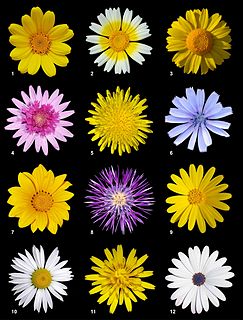
Brachylaena is a genus of flowering plants in the aster family, Asteraceae. Several are endemic to Madagascar, and the others are distributed in mainland Africa, especially the southern regions.

Isocoma menziesii is a species of flowering plant in the daisy family, known by the common name Menzies' goldenbush.
Layia gaillardioides is a species of flowering plant in the daisy family known by the common name woodland tidytips.

Leontodon taraxacoides is a species of hawkbit known by the common name lesser hawkbit, rough hawkbit, or hairy hawkbit. It is native to Europe and North Africa but it can be found in many other places across the globe as an introduced species and often a noxious weed. This is a dandelion-like herb growing patches of many erect, leafless stems from a basal rosette of leaves. The leaves are 2 to 15 centimeters long, 0.5 to 2.5 centimeters wide, entire or lobed, and green in color. Atop the stems are solitary flower heads which are ligulate, containing layered rings of ray florets with no disc florets. The florets are yellow with toothed tips. The fruit is a cylindrical achene with a pappus of scales. Fruits near the center of the flower head are rough, while those growing along the edges of the head are smooth.

Chaenactis artemisiifolia, with the common name white pincushion, is a species of flowering plant in the daisy family. It is native to the coastal Peninsular Ranges of Southern California and Baja California, in the chaparral and woodlands.
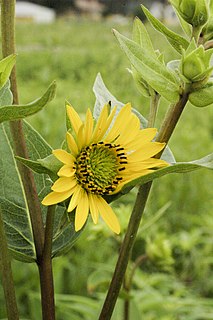
Silphium integrifolium is a species of flowering plant in the aster family, Asteraceae. Its common names include rosinweed, whole-leaf rosinweed, entire-leaf rosinweed, and prairie rosinweed. It is native to eastern North America, including Ontario in Canada and the eastern and central United States as far west as New Mexico.

Chaenactis glabriuscula, with the common name Yellow pincushion, is a species of flowering plant in the daisy family. It is native to California and Baja California.
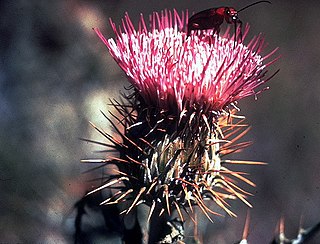
Cirsium ochrocentrum is a species of thistle known by the common name yellowspine thistle. It is native to the Great Plains of the Central United States and to the desert regions of the western United States and northern Mexico. Its range extends from eastern Oregon east to the Black Hills of South Dakota, south as far as the Mexican State of Durango.
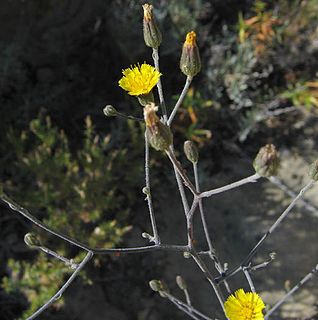
Hieracium argutum is a species of flowering plant in the aster family known by the common name southern hawkweed.

Lessingia leptoclada is a species of flowering plant in the daisy family known by the common name Sierra lessingia. It is endemic to the Sierra Nevada of California, where it is known from several types of local habitat. This is a slender annual herb growing erect and varying in size from just a few centimeters to nearly a meter tall, with long, spreading branches. It is very glandular and often hairy or woolly in texture. The upper leaves are up to 5 centimeters long, narrow and sometimes toothed or lobed; the lower leaves are longer and wither early. The flower heads appear singly or in small clusters. Each head is lined with woolly phyllaries. The head is discoid, containing no ray florets but many funnel-shaped pinkish, lavender, or light bluish-purple disc florets with large lobes. The fruit is an achene with a whitish pappus of bristles.
Lessingia micradenia is a rare species of flowering plant in the daisy family known by the common name Mt. Tamalpais lessingia. It is endemic to the San Francisco Bay Area of California, where it occurs in areas with serpentine soils. The species is divided into two rare varieties, each with a limited occurrence on opposite sides of the Bay Area. Lessingia micradenia var. glabrata is found in several locations across Santa Clara County south of San Jose, while var. micradenia is known only from a few spots around Mount Tamalpais in Marin County.

Dieteria canascens is an annual plant or short lived perennial plant in the daisy family, known by the common names hoary tansyaster and hoary-aster.
Machaeranthera juncea is a species of flowering plant in the aster family known by the common names rush bristleweed or rush-like bristleweed. It is native to northern Mexico and it occurs in the United States only as far north as San Diego County, California. It grows in coastal and inland slopes and canyons. It is a perennial herb growing erect to 1 m in height. The linear leaves are mostly located at the base of the plant, each 1–2 cm long and toothed or cut into bristle-tipped lobes. The inflorescence bears one or more flower heads lined with glandular, bristle-tipped phyllaries. The head has a center of many yellow disc florets and a fringe of 15 to 25 yellow ray florets each about 1/2 cm long. The fruit is a hairy achene 2–3 mm long tipped with a pappus.
Prenanthella is a monotypic genus of flowering plants in the daisy family. It contains the single species Prenanthella exigua, which is known by the common name brightwhite. It is native to the southwestern United States from California to Texas and it is known as far north as Idaho. Its habitat includes desert and woodlands. This annual herb produces a slender, branching stem reaching a maximum height near 40 centimeters. It has a sparse coating of glandular hairs and contains a milky juice. Most of the leaves are located near the base of the stem. They are widely lance-shaped and sometimes divided into segments. Smaller leaves occur higher on the stem; these may be reduced to scale-like structures, leaving the stem mostly bare. The inflorescence is a wide open panicle of several flower heads. Each small head is cylindrical and narrow, its base wrapped in lance-shaped phyllaries. At the tip of the head bloom 3 or 4 flowers, which are ray florets; there are no disc florets. Each floret has is white to pale pink and has a toothed tip. The fruit is a white achene with a pappus of white bristles.

Pleurocoronis pluriseta is a species of flowering plant in the aster family known by the common name bush arrowleaf. It is native to the southwestern United States and northern Mexico, where it grows in desert scrub and similar habitat. This is a clumpy or bushy subshrub reaching up to about half a meter in maximum height with many slender branches. The distinctive leaves are several centimeters in length and are mostly petiole; there is generally a toothed diamond- or arrowhead-shaped blade no more than one centimeter long at the very tip. The inflorescence is made up of one or two flower heads, sometimes more. Each flower head is somewhat cylindrical or bullet-shaped, measuring up to about a centimeter long. The head is discoid, containing only disc florets and no ray florets. It is lined with a series of many phyllaries coated thinly in glandular hairs and often streaked with purple-red coloration. The tips of the outer phyllaries curve outward. The fruit is a hairy, ribbed achene a few millimeters long with a pappus of bristles and scales on its tip.
Pulicaria paludosa is a species of flowering plant in the aster family known by the common name Spanish false fleabane. It is native to Europe, particularly Spain and Portugal, and it is known as an introduced species in California, where it grows as a weed on roadsides and other damp, disturbed areas. It is an annual, biennial, or perennial herb growing a few centimeters tall to well over a meter tall from a rhizomatous root system. The leaves are alternately arranged with blades in a variety of shapes from linear to oblong or oval. The herbage is coated in soft hairs. The inflorescence bears many flower heads. Each head has narrow, pointed, hairy phyllaries, a large dense center of many yellow disc florets, and a short fringe of many rectangular yellow ray florets, which are only about 2 millimeters long each. The fruit is an achene tipped with a pappus of bristles.
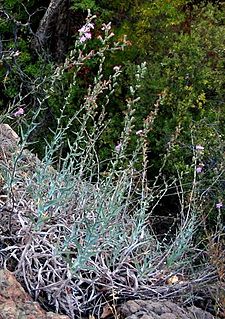
Stephanomeria cichoriacea is a species of flowering plant in the aster family known by the common names chicoryleaf wirelettuce and silver rock-lettuce. It is endemic to California, where it grows in the coastal mountain ranges as far north as Monterey County, but especially in southern California mountains such as the Transverse Ranges. Its habitat includes chaparral. It is a perennial herb producing slender erect stems reaching maximum heights exceeding one meter. The stem is woolly with hairs, especially on new growth. The leaves are mostly located in a basal rosette, the largest reaching 18 to 20 centimeters long. They are lance-shaped and often toothed along the edges, and the newer ones are woolly. Smaller leaves occur farther up the stem. The inflorescence is a long array of several flower heads, with some occurring in the upper leaf axils as well. Each head has a cylindrical base 1 to 2 centimeters long which is lined with layers of glandular phyllaries. The head contains 10 to 15 ray florets, each with an elongated tube and a pink ligule which may be up to 2 centimeters long. The fruit is an achene tipped with a spreading cluster of long, plumelike pappus bristles.
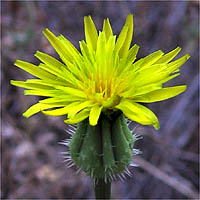
Urospermum picroides is a species of flowering plant in the aster family known by the common name prickly goldenfleece. It is native to Eurasia and it is known as an introduced species in many other regions, including North and South America, Australia, and southern Africa. It grows as a common weed in disturbed habitat. This annual herb grows up to 30 to 50 centimeters tall. It is coated in long hairs and bristles. The bristly leaves are variously shaped, often divided into many sharp-toothed lobes. The inflorescence bears flower heads on thick peduncles. The head is 1 to 2 centimeters long or more and filled with yellow ray florets. It is enveloped in several pointed phyllaries which are covered in bristly hairs. The fruit is an achene well over a centimeter in length which is tipped with a pappus of bristles.

Brachylaena rotundata S. Moore is an occasionally deciduous Southern African shrub or small tree growing to some 8m in height and of the family Asteraceae. It occurs in eastern Botswana, Transvaal, Mozambique, Zambia and Zimbabwe, growing in open woodland, on rocky koppies and slopes, and on stream banks. Kew accepts Brachylaena rotundata S. Moore as a species while 'Flora of Mozambique' treats it as a variety of Brachylaena discolor DC. It bears attractive foliage, green on the upper surface and silver-grey on the lower, leaves turning slightly reddish in autumn.
Leaves with petioles from 2 mm to 7 mm. long, lamina 4–15 x 2.5–6 cm., larger on coppice shoots, broadly oblanceolate or elliptic, obtuse to rounded at the apex, cuneate or rounded base, entire, occasionally coarsely dentate near the apex; upper surface araneous when young, or glabrescent; lower surface greyish tomentellous with prominent veins. Capitula sometimes preceding the leaves, young synflorescences with buds in axillary and terminal spikes, mature synflorescences with numerous capitula in dense terminal panicles 4–40 cm. long, or in short raceme-like panicles in axils of old leaves. Involucres cyathiform to obconic. Phyllaries minutely glandular outside, subobtuse, margins ciliolate, the outer phyllaries from c. 1 mm. long and ovate, the inner to c. 5 mm. long becoming lorate-lanceolate, narrowly obtuse or blunt at the apex; the outermost 5–8 series decreasing in size and extending down to the base of the capitulum stalk. Male flowers: corollas dull-yellow, 3–5 mm. long, lobes c. 1.5 mm. long and ± recurved; pappus uniseriate, setae 3–4 mm. long, subplumose, the seta barbs exceeding the seta axis in width. Female flowers: corollas dull-yellow, 3–5 mm. long, filiform, lobes erect up to c. 0.5 mm. long; achenes c. 4 mm. long, subcylindric-fusiform, narrowly c. 8-ribbed, pubescent; pappus 2-several-seriate, setae 4–5 mm. long, ± terete or flattened, seta barbs ± equalling the seta axis in width.""

Felicia heterophylla is a roughly hairy annual plant in the daisy family. It has alternate leaves of 1–5 cm long with an entire margin or few inconspicuous teeth. The flower heads are set individually at the tip of its stems, and contain a whorl of purplish blue ray florets around a center of blackish blue disk florets. Flower heads appear in winter and spring. It is called true-blue daisy in English and bloublomastertjie in Afrikaans. It is an endemic species that only occurs in the Western Cape province of South Africa.


